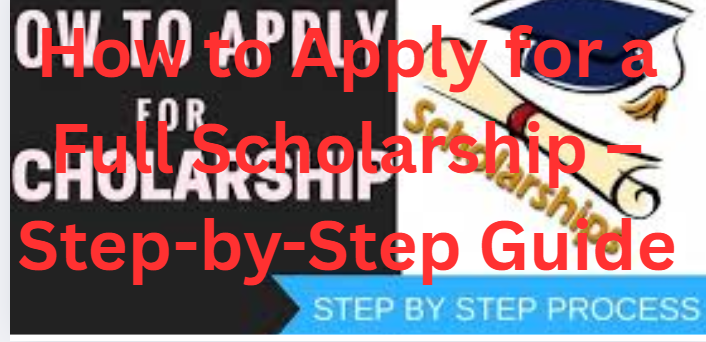Your academic path can be totally transformed with a full scholarship. Books, lodging, tuition, and occasionally even personal expenditures may be covered. However, obtaining one is not simple.
It requires more than just strong marks to distinguish out because so many students apply each year. Even if you’ve never applied for a full scholarship before, you’ll discover how to do it step-by-step in this guide. Your chances of success will increase if you pay close attention to these pointers.
Recognize the Coverage of a Full Scholarship
Before applying, make sure you know what the scholarship offers. Some full scholarships cover only tuition, while others include living costs, travel fees, and even laptops or monthly stipends.
It’s also important to know who the scholarship is for. Some are for students from specific countries, others for those with high academic performance, leadership skills, or financial need. Read the requirements carefully.
Start Early and Do Your Research
One of the most common mistakes students make is applying too late. Scholarship deadlines often come months before the academic year begins.
Start searching for scholarships as early as possible. Visit school websites, scholarship portals, and education blogs. Focus on scholarships related to your field of study, location, or background.
Choose the Right Scholarship for You
Don’t apply to every scholarship you see. Focus on ones that match your strengths. For example, if you’re a science student with high grades, look for STEM-related scholarships. If you have leadership experience, search for leadership or community impact scholarships.
Look out for full scholarships from:
– Government programs (e.g., Chevening, DAAD, Fulbright)
– Universities (e.g., Oxford, Harvard, University of Toronto)
– Private organizations or foundations
Prepare All Required Documents
Each scholarship has its own list of required documents, but most full scholarships usually ask for:
– Academic transcripts
– Certificates (WAEC, NECO, or equivalents)
– Recommendation letters
– A personal statement or essay
– Proof of income (for need-based scholarships)
– Passport or valid ID
– Language test results (IELTS, TOEFL, or equivalent if applying abroad)
Make sure your documents are clear, updated, and properly scanned. Don’t wait until the last minute to prepare them.
Write a Compelling Personal Statement
This is one of the most important parts of your application. A personal statement is where you tell your story — your goals, your passion, your background, and why you deserve the scholarship.
Tips for writing your personal statement:
– Start with a strong introduction
– Share your academic and personal journey
– Explain your goals and how the scholarship will help
– Show your passion for your chosen field
– Keep it simple, clear, and honest
Avoid copying from the internet. Write in your own words. Scholarship committees want to hear your voice.
Get Strong Recommendation Letters
Ask your teachers, lecturers, or mentors who know you well to write your recommendation letters. Give them enough time to write, and explain the purpose of the scholarship to help them tailor the letter properly.
A good recommendation letter highlights your strengths, achievements, character, and potential.
Apply Before the Deadline
Apply a few days or weeks prior to the due date. This allows you time to correct any mistakes and prevent problems like a bad internet connection or missing files. Verify again that you have used the correct email address, submitted all necessary files, and responded to all questions.
Get ready for interviews, if necessary.
Some full scholarships include an interview stage. This might be in person or online. The panel may ask questions about your background, goals, achievements, and why you deserve the scholarship.
Practice speaking clearly, stay calm, and be confident. You don’t need to be perfect — just be real and passionate.
Follow Up and Keep Applying
If you don’t hear back after applying, it’s okay to send a polite email asking for updates. But also keep applying to other scholarships.
Don’t rely on just one application. The more scholarships you apply to, the better your chances.
Final Tips for Success
- Maintain a professional tone in your emails;
- keep track of deadlines to stay organized;
- Practice responding to academic questions and composing essays.
- Participate in Facebook groups or forums where students exchange possibilities.
- Remain optimistic and dependable.
Conclusion
It takes work to get a full scholarship, but the effort is worthwhile. Be organized, start early, and provide your best effort in each section of your application. Tell your narrative honestly and highlight your qualifications as a candidate.
